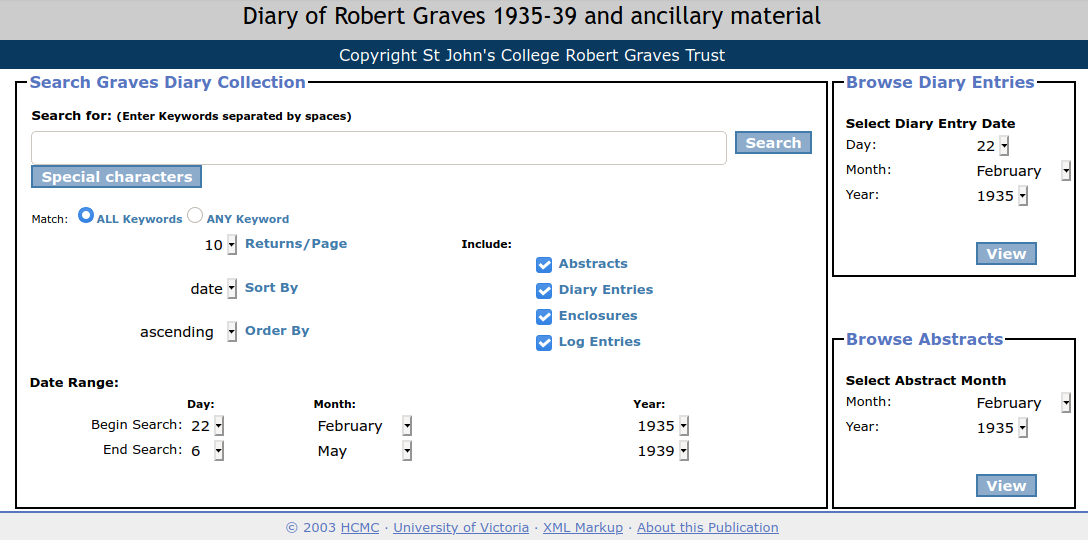About the Robert Graves Diary project
This project is a collaboration between the University of Victoria Humanities
Computing and Media Centre and the UVic Libraries. The original diary manuscripts, which consist of 1546 pages including 117 enclosures
(letters, clippings, photographs post cards, notes, games etc.), are held in the
UVic Libraries Special
Collections. Detailed information about the diary itself, its history and
provenance, is available on the Special Collections project page.

The digital edition you see here was one of the earliest TEI XML-based digital editions
undertaken by the UVic HCMC, in the early 2000s. It has undergone many revisions,
but we have
attempted throughout the process to maintain the original look-and-feel of the digital
edition, since we feel that the interface itself is an artifact of significance in
the
short history of digital humanities and online scholarly publication. This is a brief
outline
of the major stages in the project. (See also this conference presentation from 2005.)
The original transcription was made by Beryl Graves from photocopies some time prior
to 1983. This was annotated by Karl Goldschmidt, Graves's secretary. In the 1990s,
William Graves provided further annotations and information on places, people, titles
and other related information.
The manuscript contents were photographed in 2002 by Chris Petter of Special Collections.
The text was encoded in XML using a TEI P4 DTD by Linda Roberts. Chris Petter, and
Jessica Posgate.
Elizabeth Grove-White provided editorial expertise. Martin Holmes wrote a simple online
database
to manage linked references.
Monthly abstracts were written by Jillian Shoichet.
Between 2003 and 2005, Spencer Rose created an interactive web application based on
an early
version of the eXist XML Database engine.
Between 2005 and 2010, Martin Holmes maintained and updated the web application, adding
some functionality relating to enclosures.
In 2010-2011, Michael Joyce ported the original Web application to a new platform
based on more modern versions of the Cocoon and eXist software packages.
In 2015, Martin Holmes converted the TEI P4 XML to P5, along with the data from
the original reference database.
In 2016-2018, Martin Holmes and Joey Takeda, as part of the
Endings Project,
rewrote the entire project to create a portable, static web application suitable for
long-term archiving. Originally, the new version also ran in eXist in order to provide
search functionality,
but it was used as the pilot project to develop alternative approaches to search.
At one point,
the project had four distinct
search engines, an odd situation arising out of our research into how best to provide
search
functionality to a digital edition project over the long term. The conference presentation
Why do I need four search engines? discusses this incarnation of the project.
During 2019 and 2020, Holmes and Takeda's work gave birth to the staticSearch project, which now provides the search for the current
version of the Diary. The project was also slightly
reorganized to provide a real home page; previously, the search interface was the
home page, which was a little unusual.
The site includes the HTML version of our project documentation.